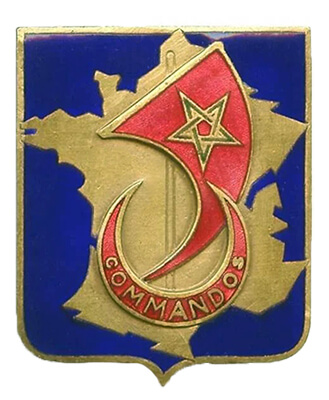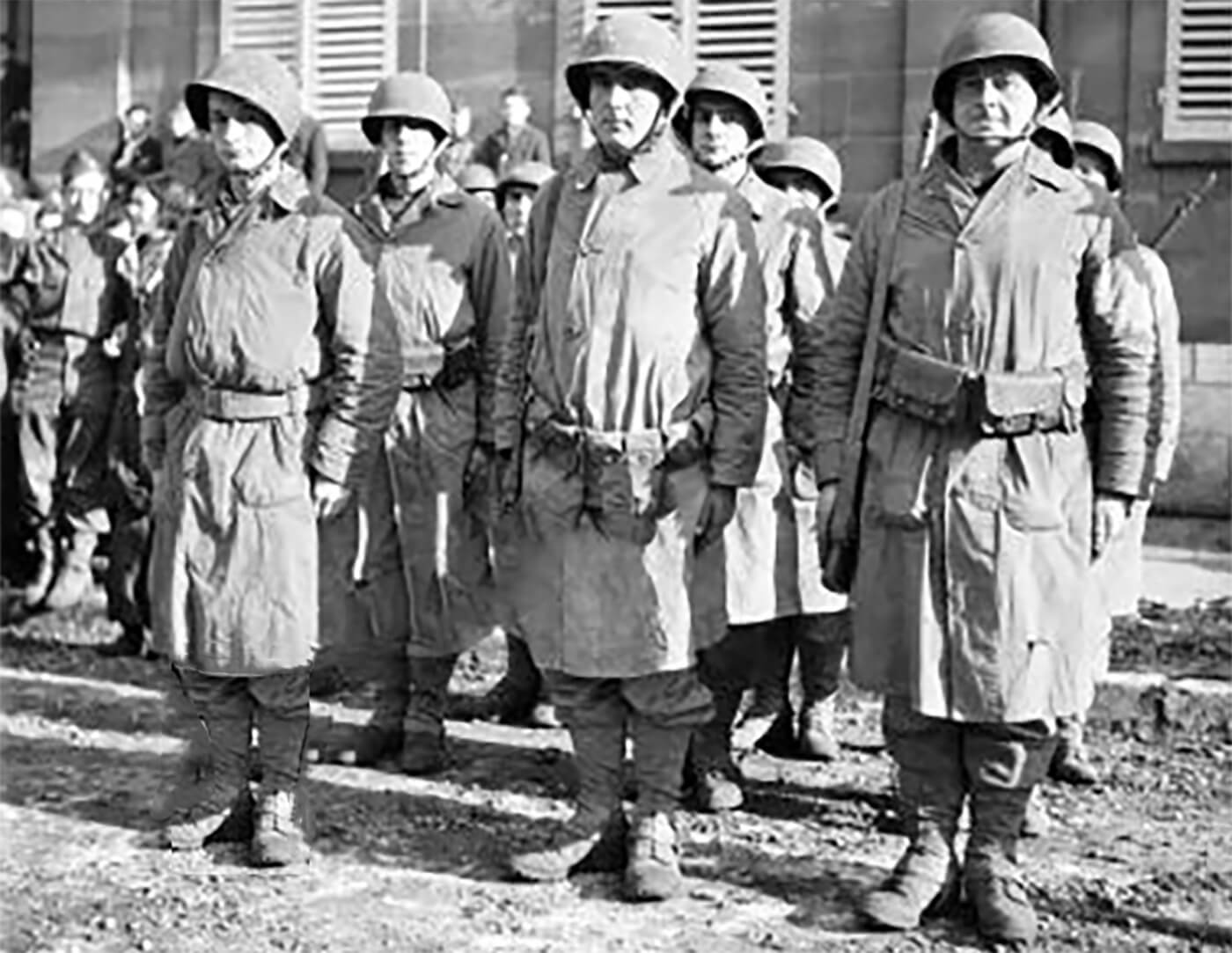| Page Created |
| January 31st, 2024 |
| Last Updated |
| February 20th, 2024 |
| France |
 |
| Additional Information |
| Unit Order of Battle Commanders Operations Equipment Multimedia References Biographies |
| Badge |
 |
| Motto |
| – |
| Founded |
| July 26th, 1943 |
| Disbanded |
| October 1st, 1945 |
| Theater of Operations |
| Algeria Elba, France France Belgium Germany |
| Organisational History |
On December 12th, 1942, the Corps Franc d’Afrique is formed. After the disbandment of the Corps Franc d’Afrique, the Groupement de Commandos d’Afrique, is established on July 26th, 1943. This specialised unit, composed of veterans from the Corps Franc d’Afrique, volunteers from North African troops, escapees from France, and indigenous riflemen from Algeria and Morocco, demonstrates a diverse and robust capability.
The Commandos d’Afrique, initially stationed in Algeria, undergoes rigorous training before relocating to Corsica in December 1943. In January 1944, they continue their training in Bastia, Saint-Florent, and Ajaccio, with a recruitment and instruction element established in Zéralda, Algeria.
The unit’s first significant operation is a raid against Pianosa Island in February 1944, which, despite an initial failure, ultimately succeeds in March. A subsequent operation along the Italian coast in March faces setbacks.
From June 17th, 1944, to June 20th, 1944, the commandos participate in the liberation of Elba Island. After this, they return to Corsica and move to Civitta Vecchia, Italy, in July for specialized training for the Provence landings. They contribute significantly to Operation Dragoon in August 1944, landing at Rayol-Canadel and Cap Nègre and engaging in a series of actions, including the liberation of Lavandou and the capture of the Mauvannes battery and Fort du Coudon, culminating in their entry into Toulon.
In August 1944, the unit’s structure includes a Commando de Commandement (Command Commando) of command under Captain Aquilina, with three Choc Commandos each with 206 men (5 officers, twenty-nine non-commissioned officers, and 172 commandos), and an accompanying commando, leading to a total theoretical strength of 1,061 personnel. The 1er Choc Commando comprises Europeans led by Captain Ducournau, the 2e Choc Commando consists of Moroccans under Captain Thorel (later succeeded by Métivier after Thorel’s death on August 17th, 1944), and the 3e Choc Commando includes Algerians commanded by Captain Bonnard. Additionally, there’s a Commando d’Accompagnement (Supply Commando) under Captain Farret.
Post-Operation Dragoon, the commandos are stationed in Marseille from September to October 1944. A second battalion is formed, incorporating the Forces Françaises de l’Intérieur, F.F.I. from the Commandos de Provence group. The unit then moves to the Jura region.
In November 1944, they engage in combat for Belfort, fighting in Chagey, Chalonvillars, Cravanche, Belfort, Valdoie, and Offemont. December sees them stationed in Giromagny.
On January 5th, 1945, several units are reorganised into six Bataillons de Choc. The original Bataillon de Choc becomes the 1er Bataillon de Choc, 1er Choc. The Janson de Sailly Batallion is reformed as the 2e Bataillon de Choc, 2e Choc. The Commandos de France are transformed into the 3e Bataillon de Choc, 3e Choc. The Commandos de Cluny establish the 4e Bataillon de Choc, 4e Choc. The Groupement de Commandos d’Afrique is reorganised into the 5e Bataillon de Choc, 5e Choc under Commander Ducournau, while the Groupement de Commandos de Provence and the Commandos de Paris/Bataillon Désiré become the 6e Bataillon de Choc, 6e Choc.
On 18th January 1945, these six Bataillons de Choc form three Groupements de Commandos de Choc, each comprising two Bataillons.
- The 1er Groupement de Commandos de Choc, led by Lieutenant Colonel Gambiez, includes the 1er and 3e Bataillon de Choc.
- The 2e Groupement de Commandos de Choc, under Commander Quinche, consists of the 2e and 4e Bataillon de Choc.
- The 3e Groupement de Commandos de Choc, commanded by Lieutenant Colonel Bouvet, encompasses the 5e and 6e Bataillon de Choc.
On March 17th-18th, 1945, the unit crosses the Rhine. In a daring overnight operation, they cross the formidable river, securing crucial positions that facilitate the subsequent Allied push into Germany. From here they advance to the Danube in Baden-Württemberg. after which they are part of the campaign through the challenging terrain of the Black Forest. This highlights the adaptability and endurance of the unit. Their ability to navigate and fight in such difficult conditions exemplifies their elite status and plays a crucial role in the final stages of the conflict in Europe.
On September 6th, 1945, Commander Ducournau takes command of the 3e Groupement de Commandos de Choc, leading to its eventual dissolution on November 1st, 1945.
The three Groupements de Commandos are reformed to the three Bataillons of the 1er Régiment d’Infanterie de Choc Aéroporté, 1er RICAP.
- 1er bataillon: consisting of the 1er Bataillon de Choc and 2e Bataillon de Choc.
- 2e bataillon: consisting of the 5e Bataillon de Choc and 6e Bataillon de Choc.
- 3e bataillon: consisting of the 3e Bataillon de Choc and 4e Bataillon de Choc.
Throughout the conflict, the Groupement de Commandos d’Afrique suffers significant losses, with an estimated 300 killed in combat and around 60 missing. Their story reflects the diverse composition and the critical role they played in key military operations.

